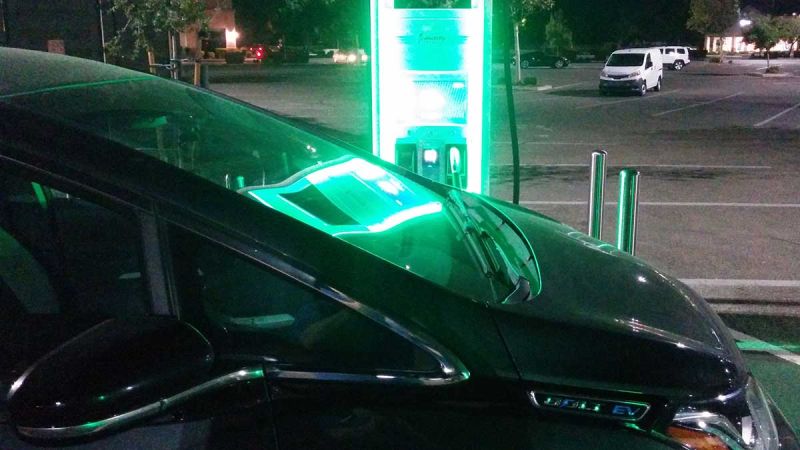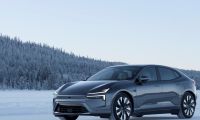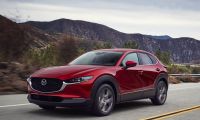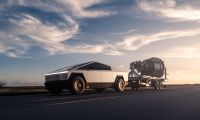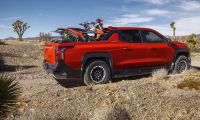Welcome back! This is Part 2 of a three-part series where I detail how to travel long distances in a Chevy Bolt EV. If you haven’t already done so, I highly recommend checking out Part 1 before reading this story. In this article, I will provide a review of the first 500 miles of my 1,000-mile trip in my 2017 Chevy Bolt EV. I will describe the driving conditions and track the time spent charging, cost for electricity, and average trip speed.
Heading Out After Work
I got to work a little later than I wanted due to packing for the trip, so I got a late start to my trip. I initially planned on leaving early afternoon, but I ended up heading out at 3:15 pm. Thanks to my work charging, I was able to leave with a full battery (not bad for $3.00). The plan was to head for the EVgo charger in Selma (about 200 miles out), but I would keep an eye on my battery levels as I approached the EVgo charger in Delano and stop if necessary.
I ended up taking the “back way” out of Ventura County, Highway 23 over Grimes Canyon and on to Highway 126. Highway 23 is a slow, winding road that shaves about 10 miles off the trip distance, but it according to Google Maps, this route actually saved me nearly an hour of trip time compared to the all-freeway route on Highway 118 to Interstate 5 (I-5). Highway 126 connects with I-5 just north of Santa Clarita, so it enabled me to avoid the Southern California rush-hour traffic that had already started.
The trip was going smoothly, but by the time I reached the 4,144’ summit at Tejon Pass, my efficiency was down to 3.1 mi/kWh. Lower efficiency is the price EV owners need to pay for driving fast, especially up a steep mountain. At the summit, my Bolt EV’s Range Estimator (in my opinion, the most accurate of any electric vehicle) told me that I had no chance of making it to the Selma EVgo charger; however, what goes up, must come down. By the time I reached the base of the Grapevine, the Bolt EV had regenerated enough energy that Selma was now back within the minimum range displayed on the Range Estimator.
Google Maps was displaying a 10+ minute delay due to road construction and an accident, which would put my arrival time in Selma at 6:30 pm (almost exactly what I had anticipated when planning the trip), but by the time I had arrived at the slowdown, traffic had already broken up. It was clear sailing on a 70-mph freeway.
Also, based on the weather reports, I should have been facing a 10-mph headwind; however, the winds appeared much lighter, and they certainly weren’t impacting my efficiency. By the time I was approaching the EVgo site in Delano, my Bolt EV was still registering between 40% and 45% battery, which was more than enough energy to make it the remaining 65 miles to Selma while keeping up with the flow of traffic.
I have a basic rule of thumb for driving the Bolt EV at freeway speeds. Unless the weather or conditions are exceptionally bad, I assume that I can travel about 50 miles on every 25% battery (essentially, a 200-mile range on a full battery). So, in this case, having 40% to 45% battery meant that 65 miles should be no problem. The only issue was, I still hadn’t seen any updates on PlugShare regarding the status of the EVgo chargers in Selma. All I could go by is that the app said they were open and available.
First Charging Stop at EVgo, Selma: 198.1 Miles
I arrived in Selma at 6:18 pm, just 3 hours and 3 minutes to travel 198.1 miles. I was nearly 15 minutes ahead of schedule, and despite taking the slower back route, I was able to maintain an average driving speed of just under 65 mph while avoiding an extra stop in Delano.
My Bolt EV’s battery was at 5% after using 52.7 kWh (an efficiency of 3.76 mi/kWh), and I do understand that many are not comfortable with dipping that low. However, I must emphasize that I passed several DC fast charging sites before getting to this point, and something as simple as reducing my driving speed by 5 mph would have allowed me to arrive with 10% to 15% battery.
During peak times, EVgo chargers are limited to 45-minute sessions for full members such as myself, so I planned to let the session run its course. These chargers are the 125 A, “50 kW” units, which are slow by current public charging standards, so a full 45-minute session is barely able bring the Bolt EV from 5% to its first charging taper point at around 50% battery. In fact, the Bolt EV would still be pulling full power from this charger up to 65% to 70% battery, though a portion of that power would be running battery conditioning and HVAC systems.

Rather than sitting around, twiddling my thumbs and watching the charger tick up, I headed off to the Spike and Rail restaurant on the other side of the parking lot. This is one of my favorite dinner sites along the route, but it can take a while to get my food and the check. Things went quickly tonight, so I was able to return to the Bolt EV before the 45-minute session had ended. I didn’t have long to wait, and the few minutes I had left in the session were enough time for me to get prepped and ready to leave for the next leg of the trip.
The session ended at 45 minutes and 48 seconds. My Bolt EV’s battery was up to 58% with 33.3 kWh of energy delivered from the charger, an average charge rate of 43.6 kW (about the best one can expect from these 50 kW chargers). For full members such as myself, EVgo charges $0.26 per minute in the greater California area, so this session cost me $11.96 (about $0.36 per kWh or about $0.10 per mile at my current efficiency).
I headed out from Selma at 7:05 pm, so my average trip speed upon departure had dropped to 51.7 mph. I was able to make decent speed for this next leg of the trip despite having to slow down as I drove through Fresno and running into road construction areas. Several portions of the freeway were shut down to only one or two lanes and expecting California drivers to be courteous for the greater good is just a little too much to ask. Also, the forecasted head winds finally showed up, so my efficiency started to drop to closer to what I had initially anticipated. As I approached the Turlock Electrify America site, I ran into one last road construction delay, and I was forced to drive past the off ramp and circle back through a detour on city streets.
Second Charging Stop at Electrify America, Turlock: 297.4 Miles
I arrived at the chargers at 8:33 pm (5 hours and 18 minutes since I left) after driving 297.4 miles, so my average trip speed was back up to 56 mph. At this point, my Bolt EV had used 80.4 kWh (an efficiency of 3.7 mi/kWh), and the battery was down to 10%. The site was still new, so only three of the chargers were on. However, all the chargers were open and available, and I was able to start my charge session with the Electrify America app right away.
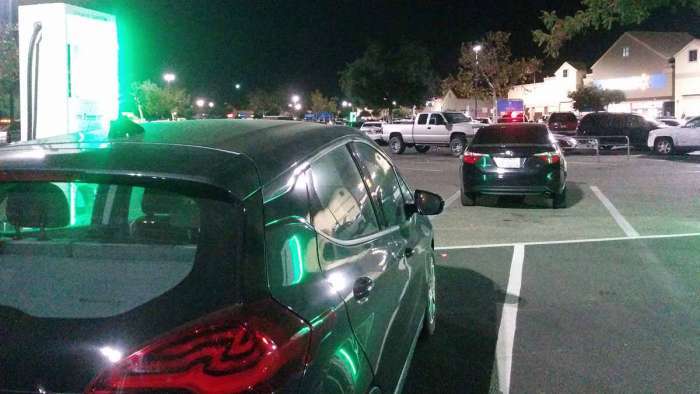
After running to the store, I spent the rest of the time reviewing the site. My review went long, so I ended up charging longer than I had intended. However, that turned out to be a good thing because the winds were starting to pick up and the temperatures were starting to drop. I charged for a total of 37 minutes 54 seconds, and in that time, the charger delivered 31.26 kWh (an average charge rate of 49.4 kWh) and brought the battery back to 60%. The total cost for the charge was $6.82. I left Turlock about 9:15 pm, dropping my average trip speed to 49.6 mph.
The trip to Sacramento International Airport continued recent trends. I had to take detour just to get back on the freeway, and Google Maps routed me to I-5 through Stockton (on Highway 4) in order to avoid an accident and even more road construction in Sacramento. The winds continued to pick up, and the temperatures had dropped to the high 40s Fahrenheit. So far on this trip, I had gone from needing the air conditioner to needing the defroster.
Third Charging Stop at Electrify America, Sacramento International Airport: 396.7 Miles
I was making good time, and I arrived at the Electrify America site at Sacramento International Airport at 10:42 pm, 7 hours and 27 minutes and 396.7 miles into my trip. I was now averaging a trip speed of 53.2 mph, and I had used 110.3 kWh of energy (an efficiency of 3.6 mi/kWh). All the chargers were available when I pulled in; however, this site is very busy. After I pulled in, several internal combustion vehicles pulled in and parked (maybe thinking it was okay). Most left quickly when they realized that my Bolt EV was a real-life electric car using the chargers.
I should have pulled in better, though, because the cord had to stretch a bit to reach my Bolt EV. It activated initially, but it quickly threw back an error and the charger shut off. I tried to restart that charger, but it looks like these chargers won’t restart immediately after a cord connection error. I moved to another charger (this time pulling all the way up to the bump stop), and the charger activated and stayed charging – no issues.
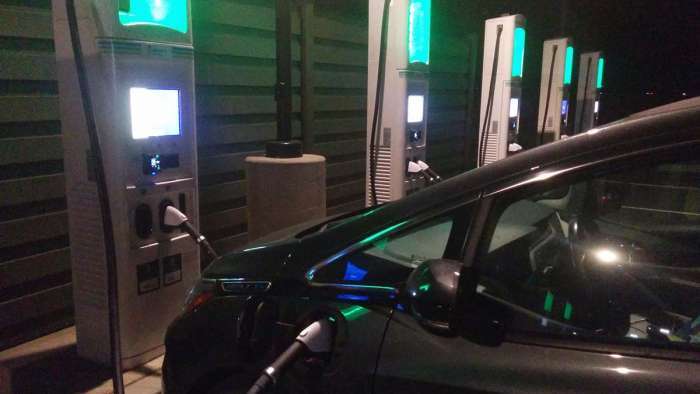
When I started the charge session, my Bolt EV had 7% battery. This final leg was going to be the most energy intensive despite being the shortest, and that was because my destination was well over 1,000 feet higher in elevation.
This charge session lasted 37 minutes and 31 seconds, and my Bolt EV had charged up to 58%. Even though this session was slightly shorter than the one in Turlock, the charger dispensed slightly more energy at 31.82 kWh (an average charge rate of 50.9 kW). The reason this session drew extra energy was that I had run the heater and defroster for the last few minutes of the session (the Bolt EV will pull extra power from the charger after it initially steps down its charge rate). The total cost for this session was $6.75.
I didn’t end up leaving the airport until almost 11:30 pm, which meant my average trip speed had slipped back to 48 mph.
Final Stop in Northern California: 482.6 Miles
This final leg goes quick because it’s a more rural section of I-5, and the back-country roads are usually traffic free at that time of night. My efficiency, of course, took a beating on this final section, but I arrived at 12:46 pm (9 hours and 31 minutes after I left work) with 5% battery. The total distance was 482.6 miles, meaning I had maintained an average trip speed of 50.7 mph. I had used a total of 139.6 kWh of energy, with a trip efficiency of 3.46 mi/kWh.
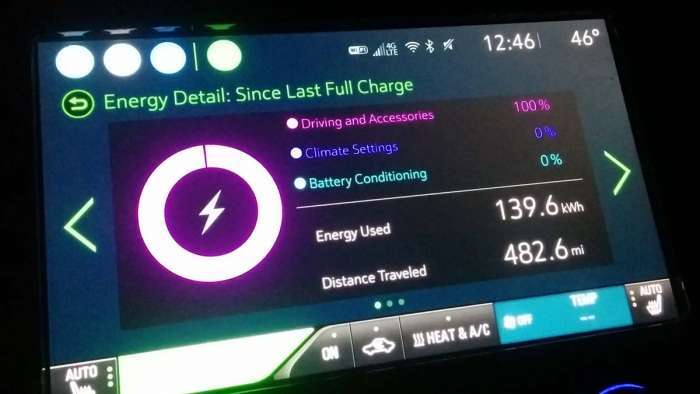
All that I had left to do at this point is plug into the L2 AC charger and head to bed. I typically have about 150 miles of driving and errands to do while in Northern California, and my JuiceBox is more than up to that task.
My Chevy Bolt Trip Summary
Here are the totals for this first 500-mile leg of the trip:
- Miles: 482.6
- Time: 9 hours 31 minutes
- Time Spent Charging: 2 hours 1 minute 13 seconds
- Average Trip Speed: 50.7 mph
- Average Driving Speed: 64 mph
- Total Trip Efficiency: 3.46 mi/kWh (289 Wh/mi)
- Total Cost: $28.53
- Cost per mile: 5.9 cents
See you next time when I share the drive home and provide a summary of the entire 1,000-mile trip!
About The Author
Eric Way focuses on reporting expert opinion on GM brand electric vehicles at Torque News. Eric is also an instructional designer and technical writer with more than 15 years of writing experience. He also hosts the News Coulomb video blog, which focuses on electric vehicles, charging infrastructure, and renewable energy. Eric is an active member of the EV Advocates of Ventura County, a volunteer organization focused on increasing the widespread adoption of electric vehicles. You can follow Eric on News Coulomb Youtube, on Facebook at @NewsCoulomb as well as on Twitter at @eway1978.


